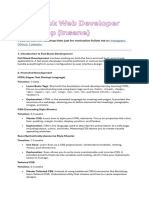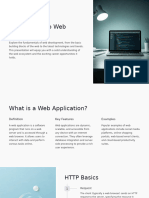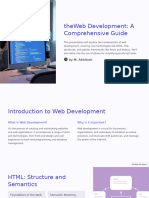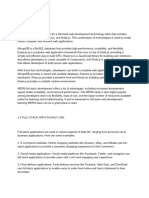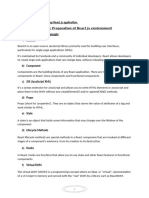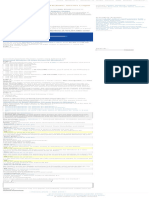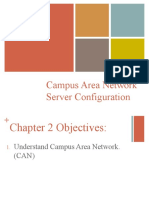0 ratings0% found this document useful (0 votes)
17 views1-Introduction-to-Integrative-Programming-and-Web-Technologies
Java and react
Uploaded by
nocttieaCopyright
© © All Rights Reserved
Available Formats
Download as DOCX, PDF, TXT or read online on Scribd
0 ratings0% found this document useful (0 votes)
17 views1-Introduction-to-Integrative-Programming-and-Web-Technologies
Java and react
Uploaded by
nocttieaCopyright
© © All Rights Reserved
Available Formats
Download as DOCX, PDF, TXT or read online on Scribd
You are on page 1/ 2
Session 1: Introduction to Integrative Programming and Web Technologies
1. Overview of Integrative Programming
Definition and Scope
Integrative programming is the combination of different programming languages, paradigms, tools, and technologies to
build cohesive systems. This approach allows developers to leverage the strengths of various technologies, creating more
powerful, scalable, and adaptable systems. It goes beyond single-language or single-technology solutions, enabling the
integration of diverse software components to achieve common goals.
In this course, we will focus on web application integration, using technologies such as Node.js, React, MongoDB, and
RESTful APIs to create full-stack applications that are dynamic, scalable, and efficient.
Importance of Integrative Programming
1. Modern Software Development: Contemporary applications often involve multiple layers (frontend, backend,
databases, APIs) that need to work together seamlessly. Integrative programming techniques ensure effective
communication between these components, providing a cohesive user experience.
2. Efficiency and Productivity: Using the best tools and languages for specific tasks leads to more efficient
development processes. For example, Node.js enables fast server-side scripting with JavaScript, while MongoDB
offers a flexible, document-oriented database solution.
3. Scalability and Flexibility: Integrative programming allows developers to scale individual components rather
than entire systems. This modular approach facilitates easier updates and expansions as requirements change.
4. Real-World Applications: Major tech companies like Google, Facebook, and Netflix use integrative programming
to deliver seamless user experiences, manage vast datasets, provide real-time analytics, and create high-
performing applications.
Applications of Integrative Programming
Web Applications
Enterprise Systems
APIs and Microservices
Cross-Platform Development
2. Web Development Basics
Introduction to Web Technologies
1. HTML/CSS/JavaScript:
o HTML provides structure for web pages
o CSS defines style and layout
o JavaScript adds interactivity and dynamism
2. Web Browsers: Render web pages and execute JavaScript. Developer tools in browsers help with debugging and
optimization.
3. Web Standards: Set by organizations like the World Wide Web Consortium (W3C) to ensure cross-browser
compatibility, accessibility, and overall web quality.
Client-Server Architecture
1. Overview:
o Client (typically a web browser) sends requests to the server
o Server processes request and sends back responses
2. Components:
o Client-Side: Focuses on UI and user interactions (HTML, CSS, JavaScript)
o Server-Side: Manages processing client requests, accessing databases, and serving dynamic content (e.g.,
Node.js, Express.js)
o Database: Stores and retrieves data (SQL vs. NoSQL databases)
3. HTTP Protocol: Fundamental protocol for web communication, involving requests, responses, status codes, and
headers.
3. Tools and Environment Setup
Introduction to Node.js
JavaScript runtime built on Chrome's V8 JavaScript engine
Enables server-side scripting with JavaScript
Features an event-driven, non-blocking I/O model
Common use cases: Building RESTful APIs, real-time applications, command-line tools
Introduction to npm (Node Package Manager)
Default package manager for Node.js
Allows easy installation, management, and sharing of packages
Uses package.json file to manage dependencies, scripts, and versioning
Basic Setup for React
JavaScript library for building user interfaces
Component-based architecture for creating reusable UI elements
Setup using Create React App
Introduction to JSX (JavaScript XML) for describing UI in React components
4. Course Expectations, Project Ideas, and Goals
Expectations for the Course
Interactive sessions covering theoretical concepts and hands-on exercises
Active participation in discussions, group activities, and coding exercises
Assessment through quizzes, assignments, and a final project
Project Ideas
Personal blog with a content management system
E-commerce website with product listings, shopping cart, and checkout system
Real-time chat application using WebSockets
Task management tool with user authentication and RESTful API backend
Course Goals
Develop full-stack web development skills
Understand integration of frontend and backend technologies
Learn to secure web applications
Gain industry-relevant skills with high market demand
Establish a foundation for advanced topics like microservices, serverless architecture, and machine learning
integration
You might also like
- FULL STACK DEVELOPMENT GUIDE Its Time To Switch Your Career To HIGH PAYING JOBNo ratings yetFULL STACK DEVELOPMENT GUIDE Its Time To Switch Your Career To HIGH PAYING JOB32 pages
- The MERN Stack Mastering Full Stack Development (2).Pptx 20241031 113712 0000No ratings yetThe MERN Stack Mastering Full Stack Development (2).Pptx 20241031 113712 000013 pages
- Module 1 - Introduction to Web Application DevelopmentNo ratings yetModule 1 - Introduction to Web Application Development7 pages
- Lecture 1 - Introduction to Web DevelopmentNo ratings yetLecture 1 - Introduction to Web Development10 pages
- TheWeb Development a Comprehensive GuideNo ratings yetTheWeb Development a Comprehensive Guide10 pages
- Full Stack Development Mastering the Art of Building Complete ApplicationsNo ratings yetFull Stack Development Mastering the Art of Building Complete Applications10 pages
- Best Full Stack Projects Ideas for BeginnersNo ratings yetBest Full Stack Projects Ideas for Beginners9 pages
- Goa College of Engineering: "Bhausahebbandodkar Technical Education Complex"No ratings yetGoa College of Engineering: "Bhausahebbandodkar Technical Education Complex"8 pages
- V-Rep. Presentation 10: Calculation ModulesNo ratings yetV-Rep. Presentation 10: Calculation Modules34 pages
- 2071-02-15 Computer Operator Question Key C100% (1)2071-02-15 Computer Operator Question Key C4 pages
- Algoritma Dan Struktur Data: Kuliah #1 by Dr. Amil Ahmad Ilham, S.T., M.ITNo ratings yetAlgoritma Dan Struktur Data: Kuliah #1 by Dr. Amil Ahmad Ilham, S.T., M.IT23 pages
- Adaptive Server Enterprise: Performance and Tuning Series: Monitoring TablesNo ratings yetAdaptive Server Enterprise: Performance and Tuning Series: Monitoring Tables66 pages
- Windows 10 Hidden Secret Login Screen For Windows 7 - AskVGNo ratings yetWindows 10 Hidden Secret Login Screen For Windows 7 - AskVG1 page
- Chapter 2 Campus Area Network Server Configurations 2.1No ratings yetChapter 2 Campus Area Network Server Configurations 2.117 pages
- Schiphol Contact Us For Questions and ComplaintsNo ratings yetSchiphol Contact Us For Questions and Complaints1 page










